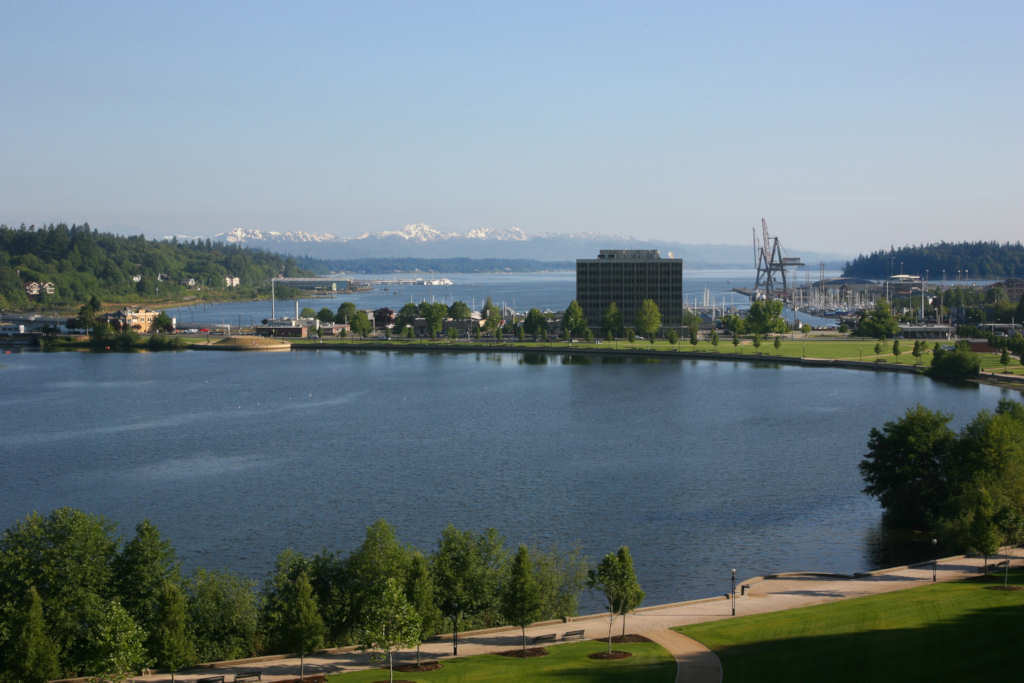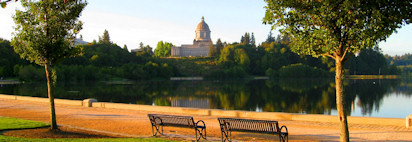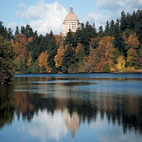Immediate & Future Restoration Options - CLIPA White Paper (part 1)
Restoring Capitol Lake to Achieve Sediment Management and a Watershed Solution
CLIPA’s group of experts serving as a “Science and Policy Panel” (Panel) has identified and reviewed over 150 various studies and reports, many of which are State-funded studies, that have evaluated how best to manage Capitol Lake.
For example, the Panel reviewed the 2004 Department of Ecology WRIA 13 Deschutes Watershed Plan and the 1996 Department of General Administration Plan to complete a maintenance dredging program, as some of the baseline documents for the long-term plan.
The Panel researched those documents, keeping in mind the intentions of the original Capitol Campus design plans, to form this vision and action plan.
Immediate Dredging and Future Options
The Capitol Lake Adaptive Management Plan Final Environmental Impact Statement (FEIS) of May 20, 1999, prepared by GA on behalf of the State, identified six alternatives for the long-term management of Capitol Lake. The FEIS referred to adoption of the 2003-2013 Capitol Lake Adaptive Management Plan, a portion of which calls for interim dredging to address current problems and develop a longer-term lake management program.3
The science is understood in this area, and the need for an active and ongoing sediment management maintenance program is defined and should proceed by fiscal year 2013 to avoid further damage caused by the lack of maintenance dredging. This recommendation was included in the 1999 FEIS and could proceed under the immediate authorization of the State Legislature and the filing for the Corps of Engineers dredging permit by GA.
The State-funded studies and the experience of environmental, regulatory, design, operation, and public policy experts assembled by CLIPA for this review support the conclusion that little additional study is needed to make an informed decision on how best to manage Capitol Lake as an integral part of the State Capitol Campus, the City of Olympia, and the larger Deschutes River Watershed including lower Budd Inlet.
The Panel’s recommendations include immediate steps during the next biennium (2011-2013) to complete predesign studies, design, and implementation of a maintenance dredge of the North basin of Capitol Lake. The dredge would begin to partially reverse the damages to both public and private investments stemming from the current “do nothing” approach.
CLIPA estimates the first two-year pre-design, dredging, and damage control project would cost about $4.5 million. We note that this dredging and damage control project would be required regardless of which long-term management program for the Capitol Lake and lower Budd Inlet is advanced.4 This first phase of activity also would include dredging of the lower Budd Inlet in the third year of the project (in the 2013-2015 biennium).
CLIPA’s vision of the Deschutes Watershed and Capitol Lake continues to advocate for the three-basin area known as Capitol Lake to be restored and maintained. However, at least in the short-term, CLIPA acknowledges that a more feasible solution of restoring and maintaining the North basin, with the possibility of some or all of the Middle basin being restored at a later date, may be a more cost-effective and viable solution.
CLIPA offers these thoughts on what this plan might look like with the caveat that additional information produced during the predesign phase may indicate options in favor of a greater percentage of Capitol Lake being restored and maintained.5 For example, the three basins may be necessary if a comprehensive management plan is not developed, funded, and implemented for the Deschutes Watershed. Lack of such a plan would allow the continuation of 35,000 cubic yards of sediment to flow annually to Capitol Lake and lower Budd Inlet.
Alternatively, some freshwater wetlands in the South basin and a portion of the Middle basin could be part of the final community strategy along with an extensive educational trails system within this urban environment (see the Lake Maintenance Plan, attached, for further details). If the upper Deschutes Watershed is managed to minimize sediment transfer and to improve water quality, the possibility of cost savings may translate into opportunities to develop such a mixed landscape. We support inclusion of an extensive environmental education and urban trails system in this program.
3 It should be noted that the estuary option was an alternative that was not selected by the GA as a project to pursue.
4The CLAMP study develop questionable cost estimates of dredging as high as $250,000,000 to $300,000,000 with predicted delays that will increase the cost of associated damages to public and private investments already made. CLIPA used actual costs from the Port of Olympia recent dredging activities and other State information that provided more accurate assessments of costs and timing.
5 At a minimum, predesign elements for this type of project should include the following: sediment removal options; how to dispose of sediment (e.g., sites, transport methods, etc.); flooding/hydrology studies; schedule and schedule constraints (e.g., fish windows); cost factors; water quality/management of land including invasive species; habitat restoration; recreation opportunities; adjacent entities planning efforts/activities (e.g., City of Olympia Boardwalk and Percival Landing); opportunities for partnerships; funding strategy (e.g., federal grants, public/private partnerships, etc.).
Monitoring and Management
Regardless of which approach is taken, we have taken a strong position that any plan adopted and funded by the Legislature must include ongoing data collection, scientific study, performance monitoring, and reporting.
What the CLAMP study brought to light by its limitations is the need for a more comprehensive, watershed-wide management planning and oversight group.
CLIPA recommends the State Legislature begin discussions around either a “coordinating board” or perhaps a Public Facilities Deschutes/Capitol Lake Management District to oversee this monitoring and reporting, and ensure a responsive approach is implemented 6.
Our recommendations include:
- Establishing a long-term management program that incorporates the protection and enhancement of an environmental and community treasure – the entire Deschutes Watershed – under the direction of a public/private “coordinating board.” The board would include representation of the impacted groups and governmental agencies and, under the authority of the State Legislature, would operate with GA functioning as the coordinating board’s technical staff.
- We recommend that a Deschutes Watershed Adaptive Management Plan be developed and implemented (with Legislative review) under the guidance of this newly established “coordinating board.” This board would begin the process of developing a rich and complementary public/private partnership, including a plan for public/private cost sharing. For example, this “coordinating board” could facilitate partnering with the Natural Resource Conservation Service and Washington Department of Transportation among others to develop sediment management plans.
- Our recommendations consider the 2011-2015 predesign study and dredging program of the Capitol Lake North basin and lower Budd Inlet/boat basin as an interim step, while the ten and twenty-year management program update is further documented in an update to the 2013 Adaptive Management Plan that will define how much of the Middle and South basins are dredged or converted to a freshwater wetland, using dredge spoils to enhance a recreation and education area.
- The updated plan will then be integrated into the more comprehensive sediment management program for the entire Capitol Lake and related Deschutes Watershed Adaptive Management Plan for implementation by the new “coordinating board.”
6 At the time of this White Paper, we had not yet fully researched the options of a “district” designation and intend to do so. This may or may not be a beneficial designation; some other approach may be more viable and effective. We also had not fully researched various models and structures for a “coordinating board.” For example, the Nisqually River watershed plan development and management process may be a useful model for these purposes, to ensure no new level of government, but to establish a new coordinating entity (e.g., the Nisqually River Council). This White Paper is intended as a starting point for such conversations.
Evolving Ideas toward a Deschutes Watershed Solution
Almost every State funded study relating to Capitol Lake, with State regulatory and resource management agency input, concludes that the most appropriate method to manage the water environment, the 35,000 cubic yards of annual sediment, and the public use and benefit of the Deschutes Watershed, Capitol Lake and the southernmost part of Budd Inlet, is the routine dredging of the Capitol Lake basins and lower Budd Inlet.
Such dredging is necessary to prevent the accumulating sediment deposition from the Deschutes Watershed from choking off open waterways and navigation. While the 2009 CLAMP study focused only on Capitol Lake and the tidal mud flat (“estuary”) alternatives, it, too, recognized that the North basin and the lower Budd Inlet need to be dredged as a first priority if the estuary proposal is advanced.
In developing a vision for the future that addresses overall ecosystem health and water quality, CLIPA was surprised to discover that the CLAMP study and previous studies excluded a Deschutes Watershed-wide approach. In our collective mind, a solution should include a watershed and basin management plan, including these goals:
- Development and enforcement of land use policies above Deschutes Falls to
increase water quality, address contaminants, and decrease sediment transport
downriver. Note that harmful chemicals bind with sediment and are carried downriver
and into Puget Sound. Solutions should include the following:
- a. Abate stormwater runoff.
- b. Localize sediments upriver via sediment management “traps.7
- c. Monitor and report the percent of sediment reduction upstream,and concomitant reductions in Capitol Lake.
- d. Decrease water temperature to healthy limits. (Increase riparian shade via tree planting, etc.)8
- e. Increase dissolved oxygen levels.
- f. Increase water circulation.
- g. Retain aesthetics.
- h. Incorporate TDML (total daily maximum load) findings from the Department of Ecology study.
- i. Track and report on bacteria entering the Deschutes River system.
- A riparian system management plan.
- A dredging management plan that takes into account fisheries resources, a distribution plan for dredge materials, armoring and contouring issues, and recreation opportunities.
- Ongoing data collection, analysis, and reporting with an updated management plan at least every 10 years.
- Formalized coordination among various jurisdictions regarding stormwater drainage, nonpoint source and point source control, sediment management, watershed improvement planning, recreation and other uses, storm event management, etc.
- Further modeling and study of the relationship between incoming tides and outgoing tides regarding sedimentation transport.
- A plan to engineer the lake floor topography to positively impact future sediment deposition.
Immediate & Future Restoration Options - CLIPA White Paper
by: CLIPA Capitol Lake Improvement & Protection Assn.Immediate and future options for restoration, monitoring and maintenance of Capitol Lake, in Olympia Wa. This is part of the CLIPA White Paper, a plan for ongoing management of Capitol Lake.


